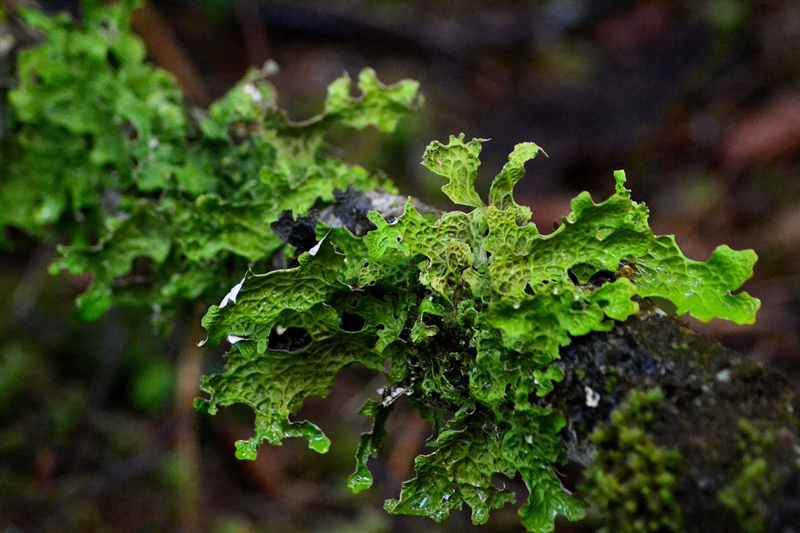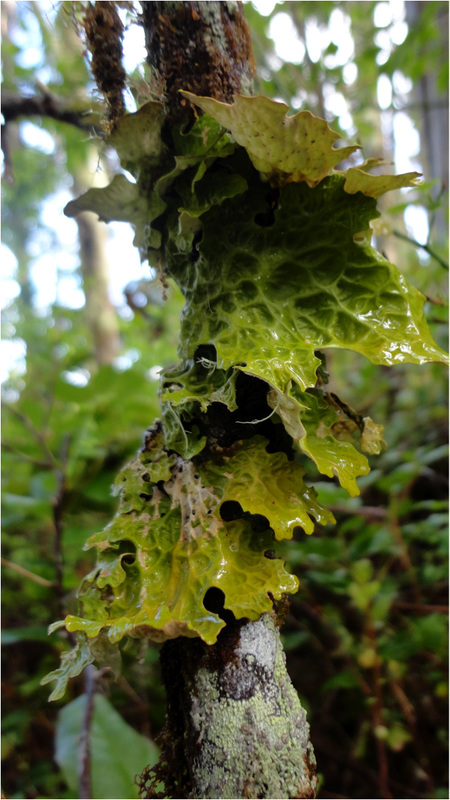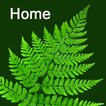Lungwort • Lobaria pulmonaria
{pulmo = lung}
Identification
Lungwort is a common and conspicuous foliose (leaf-like) lichen. Its fairly large lobes are generally 20-30 cm wide. The upper surface can be bright green (especially when moist), blue-green, grey-green or brown-green. Lobes are visibly ridged with deep depressions between ridges. When reproductive, minute powdery reproductive soredia or wart-like isidia can be found on lobe margins and ridges. Lobes are typically loosely attached at one end, and often hang from their substrate. The undersides of lungwort lobes are woolly and brown, with irregularly distributed white, hairless patches.
Habitat and Range
This species grows on trees in low-elevation coniferous and deciduous forests, as well as on moss-covered rocks in humid forests. It has circumpolar distribution; in the Pacific Northwest its range extends south to California. It is common in most suitable humid, shady, and low-elevation habitats, though it is essentially non-existent in boreal forests.
Similar Species
Lobaria linita is similar in appearance, but predominantly occurs on rocks in high elevations. Soredia and isidia are also absent. Lobaria oregana, another loosely attached foliose lichen, is more yellow in colour, lacks soredia and isidia and has very curly, frilled margins.
Human Uses
Based on the Doctrine of Signatures and this this species' resemblance to lung tissue, early Europeans used it to treat lung ailments such as pneumonia. This connection to lungs is evident in its common name as well as the latin pulmonaria.
Lungwort is a common and conspicuous foliose (leaf-like) lichen. Its fairly large lobes are generally 20-30 cm wide. The upper surface can be bright green (especially when moist), blue-green, grey-green or brown-green. Lobes are visibly ridged with deep depressions between ridges. When reproductive, minute powdery reproductive soredia or wart-like isidia can be found on lobe margins and ridges. Lobes are typically loosely attached at one end, and often hang from their substrate. The undersides of lungwort lobes are woolly and brown, with irregularly distributed white, hairless patches.
Habitat and Range
This species grows on trees in low-elevation coniferous and deciduous forests, as well as on moss-covered rocks in humid forests. It has circumpolar distribution; in the Pacific Northwest its range extends south to California. It is common in most suitable humid, shady, and low-elevation habitats, though it is essentially non-existent in boreal forests.
Similar Species
Lobaria linita is similar in appearance, but predominantly occurs on rocks in high elevations. Soredia and isidia are also absent. Lobaria oregana, another loosely attached foliose lichen, is more yellow in colour, lacks soredia and isidia and has very curly, frilled margins.
Human Uses
Based on the Doctrine of Signatures and this this species' resemblance to lung tissue, early Europeans used it to treat lung ailments such as pneumonia. This connection to lungs is evident in its common name as well as the latin pulmonaria.
References
Lobaria pulmonata (L.) Hoffm. Lungwort. In Klinkenberg, Brian. (Ed.). E-Flora BC: Electronic Atlas of the Plants of British Columbia [eflora.bc.ca]. Lab for Advanced Spatial Analysis, Department of Geography, University of British Columbia, Vancouver. Accessed 2016-03-03.
Pojar, J. and MacKinnon, A. (2005). Plants of Coastal British Columbia, Revised. Vancouver, BC: Lone Pine Publishing. P. 489
Authors and editors of page
Bea Proudfoot and Kelly Fretwell (2016)
Lobaria pulmonata (L.) Hoffm. Lungwort. In Klinkenberg, Brian. (Ed.). E-Flora BC: Electronic Atlas of the Plants of British Columbia [eflora.bc.ca]. Lab for Advanced Spatial Analysis, Department of Geography, University of British Columbia, Vancouver. Accessed 2016-03-03.
Pojar, J. and MacKinnon, A. (2005). Plants of Coastal British Columbia, Revised. Vancouver, BC: Lone Pine Publishing. P. 489
Authors and editors of page
Bea Proudfoot and Kelly Fretwell (2016)





